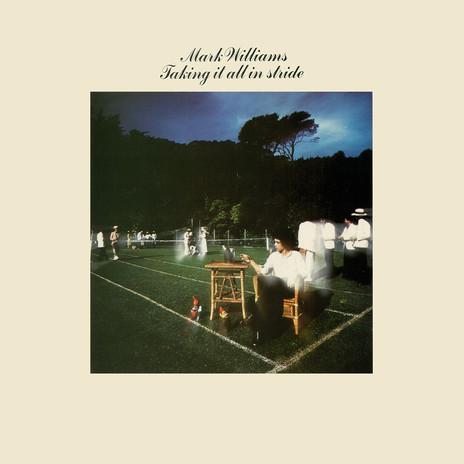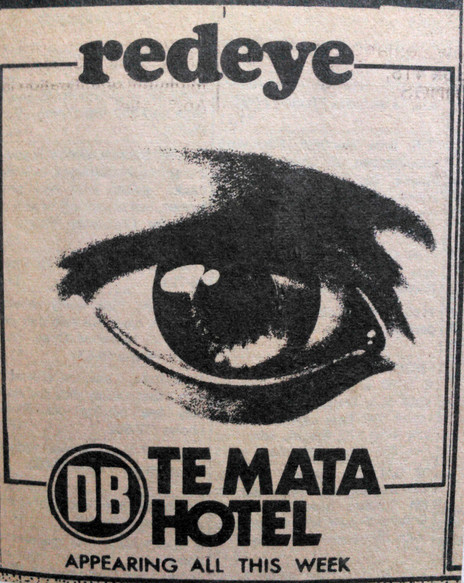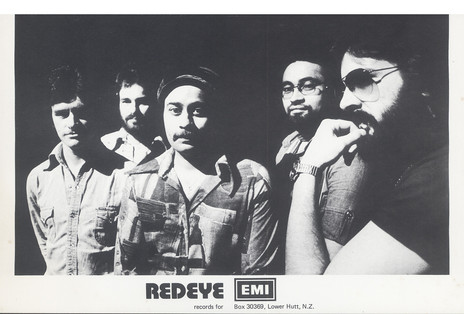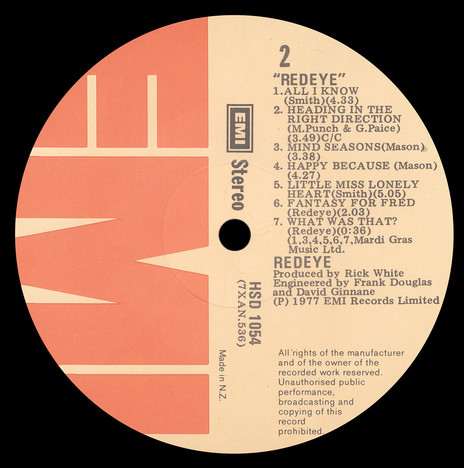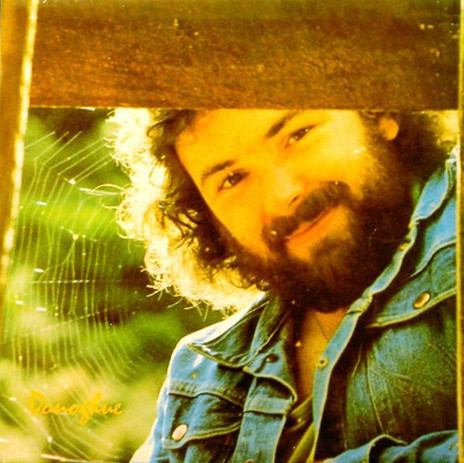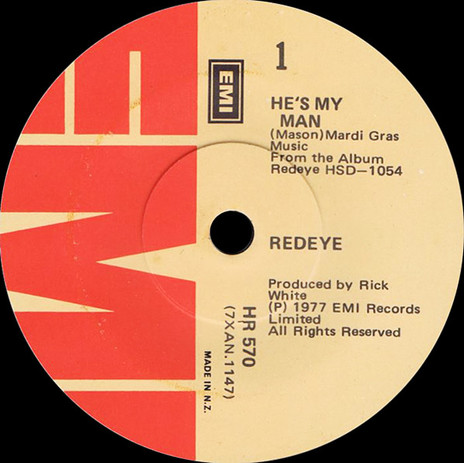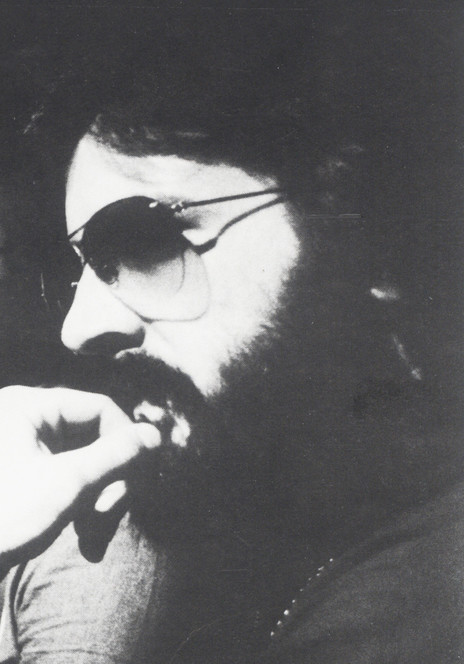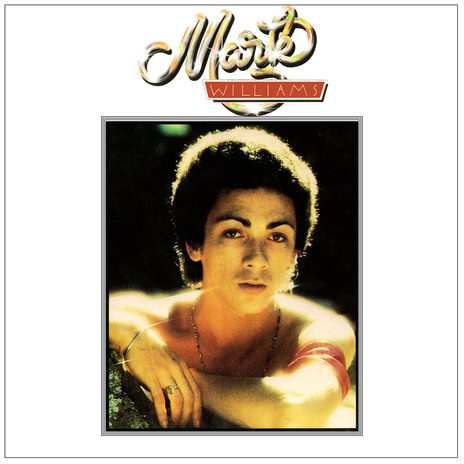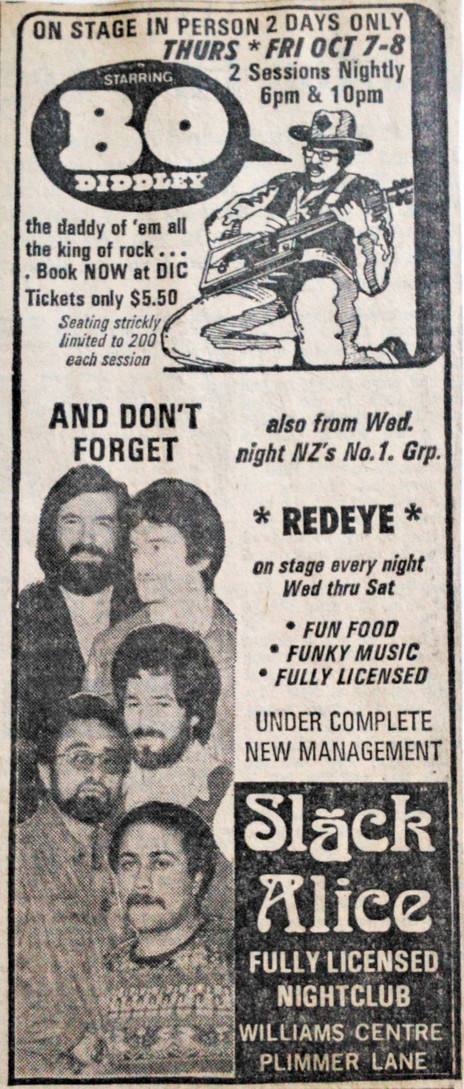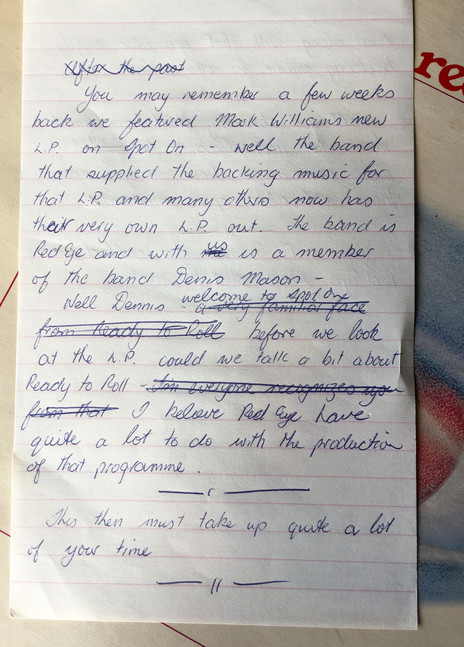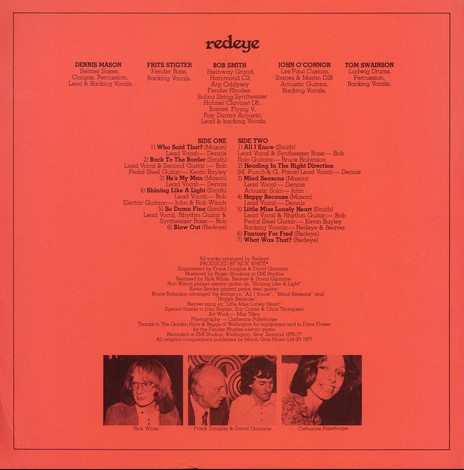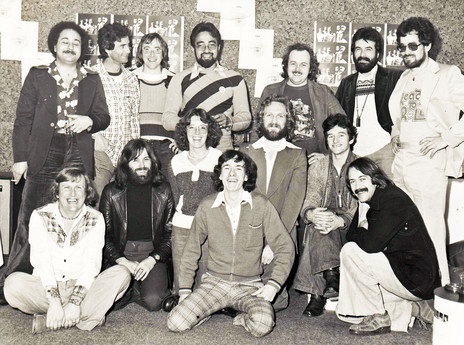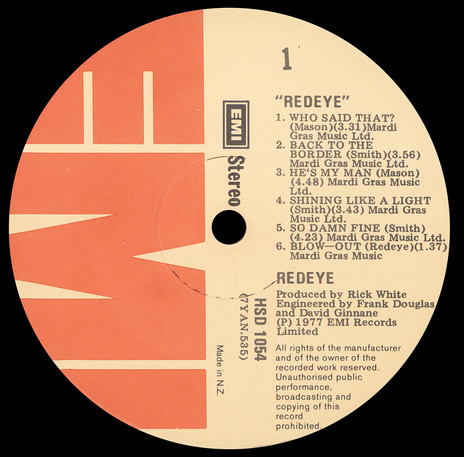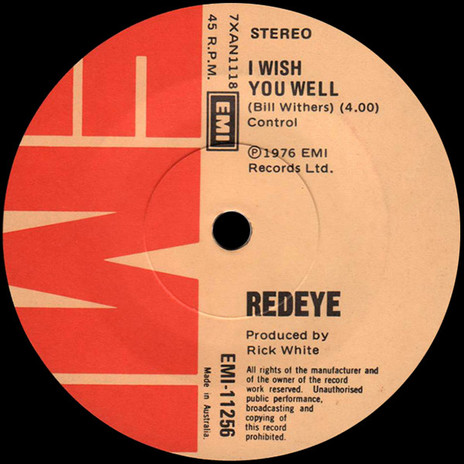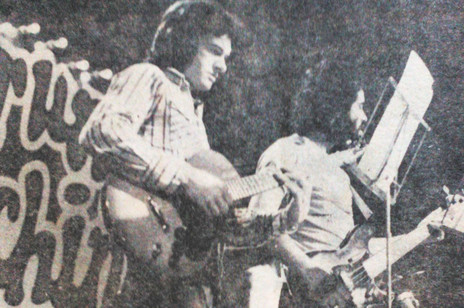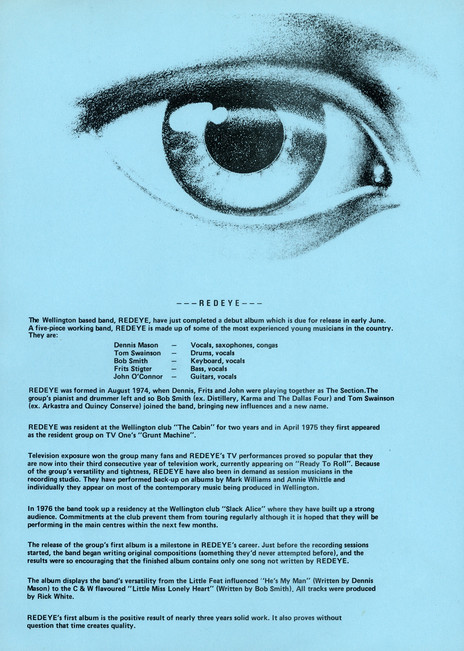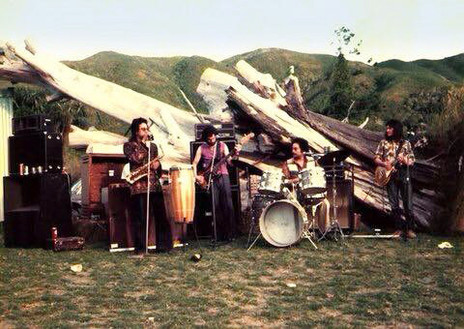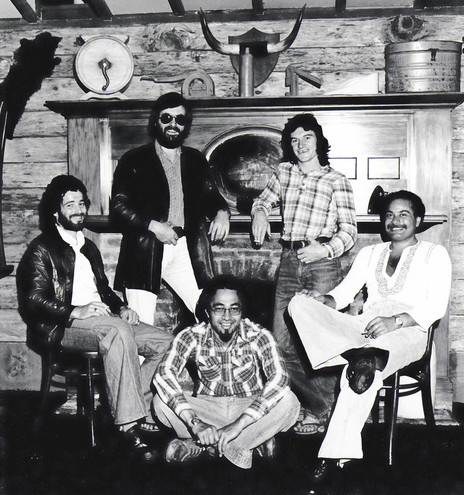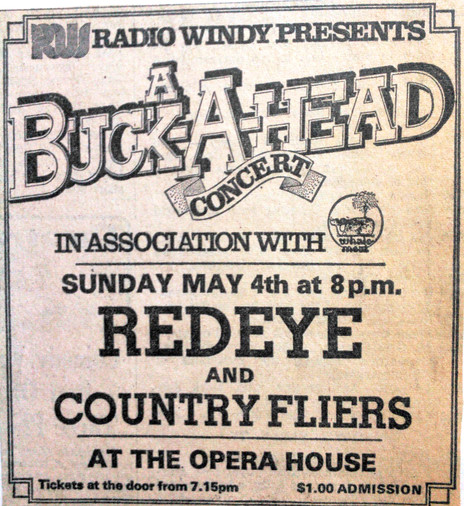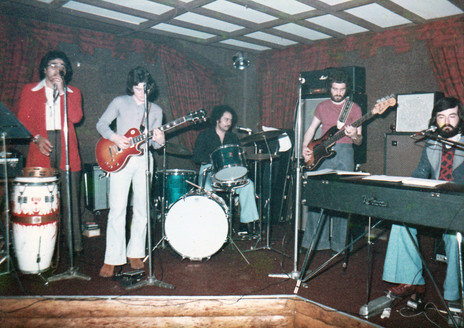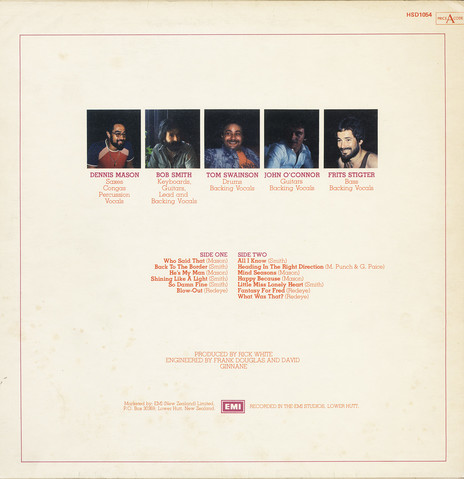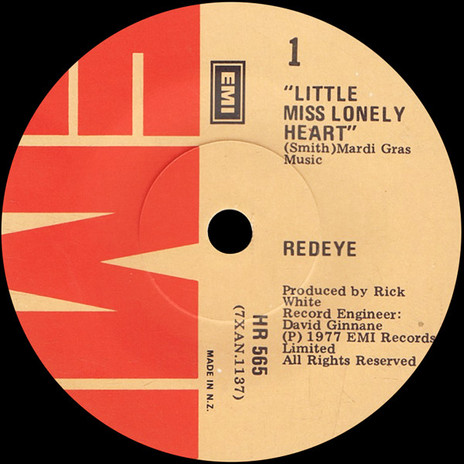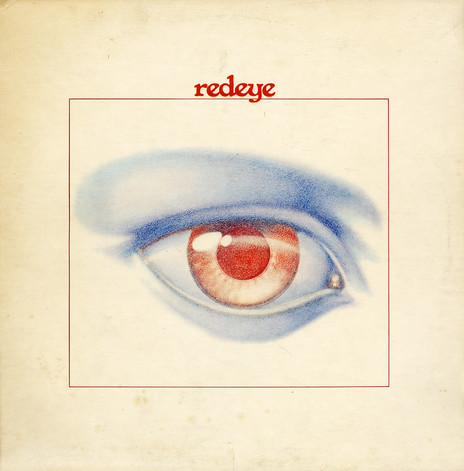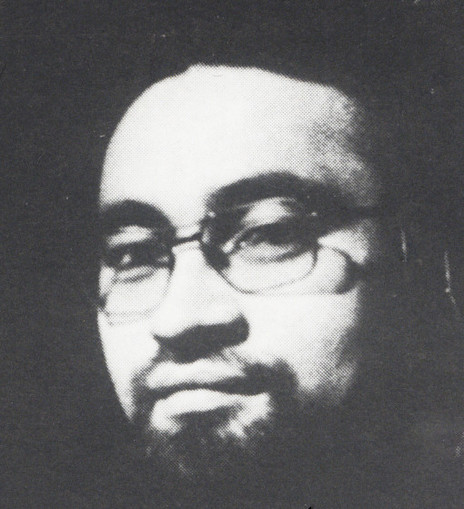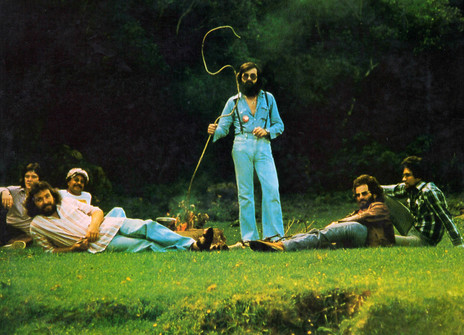When Rehu and Fox left they were replaced by keyboardist Bob Smith (The Dallas Four, Karma, Distillery) and drummer Tom Swainson (Tom Thumb, Farmyard, Arkastra, Quincy Conserve). The change was significant enough to require a new band name – and Redeye was born.
Resident band at Ray Johns’ Wellington club The Cabin (formerly The Entertainers Club) for two years, The Section/Redeye developed a strong set of soul covers with a New Orleans funk flavour – with Mason on vocals, saxophone and congas, and Smith on vocals and keyboards. They also performed as backing band for international artists who toured through the capital city.
They became well known to audiences as the backing band on ‘Ready To Roll’
In April 1975 they started appearing on TV One’s Grunt Machine, initially presented by Andy Anderson, whom Mason and Swainson had played with in Arkastra. Over the next couple of years, they became well known to television audiences as the backing band on Ready To Roll behind vocalists such as Tina Cross, Craig Scott and Steve Gilpin.
“After about a month of the show we learnt that if you make a mistake in your playing, you stop,” Denys Mason told Alastair Dougal for Rip It Up’s November 1978 issue. “Cos if you didn’t and what they’d filmed looked alright – they’d use it. We had our reputation to hang onto but they couldn’t give a shit about what we were doing musically. We stuck with it for the money but anybody who thought we were making a lot out of it is crazy.”
In May 1975, Victoria University student paper Salient reviewed Redeye as part of a “buck-a-head” show at Wellington Town Hall:
“Redeye specialises in doing Loggins & Messina better than they do it themselves and on that Sunday night they were very impressive. The main fault was their extra professionalism and polish which overshadowed any life … Yet I enjoyed this band’s particular style of soulful sound, as much as my own preconceptions of a band-audience relationship could let me. To most of the audience Redeye closed the evening with the quality of music that shows New Zealand music is often as good as imported stuff.”
In 1976 Redeye shifted to another Wellington club, Slack Alice, where they backed Bo Diddley over two nights in May. Benny Ashburn, manager of the Commodores, attended a Redeye show there after the Commodores finished their Wellington concert. He was so impressed that the following day he requested some tapes to take back to the States.
Redeye’s popularity with live audiences was high: they drew good crowds and had a reputation as a tight, funky unit. Combined with their strong individual musical histories, this led to session work, in particular at EMI Recording Studios in Wellington.
Redeye and Rockinghorse both played on Mark Williams’ self-titled 1975 debut album, produced by Alan Galbraith. Redeye’s three tracks are impressive, with two soulful covers – Brenton Wood’s ‘Gimme Little Sign’ and Stephen Stills’ ‘Love The One You’re With’ – and the glorious No.1 hit single from the album, the Vanda-Young penned ‘Yesterday Was Just the Beginning Of My Life’.
Arranged by Mike Harvey, who also played the ARP synthesiser part, and featuring the whole Redeye gang on backing vocals, the song charted at No.1 and stayed in the charts for 24 weeks. The album peaked at No.2, remaining in the charts for 30 weeks and making it the highest selling New Zealand album of the year. Denys Mason played conga for several other tracks, including ‘Disco Queen’ (a Hot Chocolate cover) and ‘Sail On White Moon’.
Redeye also provided the backing for John “Timberjack” Donoghue’s 1975 folk-rock release Donoghue on Ode Records, recorded at EMI studios in Wellington with overdubs at Stebbings in Auckland. In the liner notes, Donoghue describes Redeye as an “inspired choice” of backing band for the album:
“They were resident band at the Wellington Musician’s Club at the time, and I had enjoyed a long history with each individual member.” Mason and Donoghue had “both grown up in Miramar and kicked off their music careers off at the Wellington high school music competitions”. Smith “belonged to the crew I hung with in Auckland during the Human Instinct days and had featured in the ‘Pelorus Jack’ video”. O’Connor and Swainson had both played on his 1972 ‘Dahli Mohammed’ sessions, and Stigter was a fellow former member of The Dizzy Limits/Timberjack (the band) “and indeed was responsible for the ‘Timberjack’ name”.
Wellington Evening Post critic Graham Ingram gave the album a favourable review, noting: “Donoghue’s efforts apart, backing band ‘Redeye’ does a superb job” and they “do everything just right”.
Redeye continued to back Mark Williams, getting one track (‘Easy For Us’) on his second album, 1976’s Sweet Trials. Again, the lion’s share of tracks went to Rockinghorse.
Mark Williams’s 1977 album ‘Taking It All In Stride’ features Redeye extensively
But Rockinghorse were increasingly unavailable, mostly due to releasing and touring their own albums – and Mark Williams’ third album, 1977’s Taking It All In Stride, features Redeye extensively, across a track listing that includes soul cover ‘A House For Sale’ (earlier recorded by Mille Jackson), Holland-Dozier-Holland’s ‘Why Can’t We Be Lovers’ and the Paul Anka-penned hit ‘It Doesn’t Matter Anymore’, which reached No.1 in May 1977 and charted for 19 weeks. The single release of ‘A House For Sale’ which originally spent 10 weeks in the charts and peaked at No.13, has become something of a holy grail in recent years, fetching hundreds of dollars on the collectors market.
"It was that band who had the funk, and the soul," Mark Williams told Unsung Heroes of Māori Music," ... it's exactly the groove we wanted."
Reviewing Taking It All In Stride for Rip It Up (#1, June 1977), Alastair Dougal wrote: “The basic backing unit of Redeye play with muscle and overall the production is very fine.” He continued, “it’s the finest New Zealand recorded album in god knows how long.”
Redeye members played on many other local releases over the years with Denys Mason contributing percussion, saxophone and backing vocals to releases by Jon Stevens, Sharon O’Neill, Kim Hart and Tina Cross, and Bob Smith appearing on songs by Larry Morris, Dennis O’Brien, Jodi Vaughan and Tex Pistol. Swainson and O’Connor played on Annie Whittle’s 1976 debut album, Annie, and Mason, Stigter and Swainson provided the rhythm section for John Rowles’ 1978 release, This Is My Life.
Their debut – and only – album release, the self-titled Redeye, came about as something of an accident. One of the few original songs that Redeye performed live, the Denys Mason-penned ‘Who Said That’, came to the attention of one of EMI’s staff. The band was commissioned to record an album with Rick White (Tom Thumb, Farmyard, Taylor) as producer.
Having almost no other original material, Mason and Bob Smith wrote the tunes during the seven-month off-and-on recording process. Three singles were released as a result: ‘Who Said That’ b/w ‘I Wish You Well’ (1976), ‘Little Miss Lonely Heart’ b/w ‘Mind Seasons’ (1977), and ‘He’s My Man’ b/w ’So Damn Fine’ (also 1977).
“We were getting a hell of a lot of TV coverage and nothing had come out of it,” Mason told Alastair Dougal (Rip It Up, 1978). “So we thought we might as well cash in on it since we were unable to move outside of Wellington because of the work we were doing.”
Sales were slow with only around 400 copies of the album sold, 250 of those in the Wellington area. The marketing drive was almost non-existent, with EMI handing the band members a pile of spare, unfolded album covers to use as retail window displays.
Reviews of the album, though not outright damning, reflected the inexperience of the two fledgling songwriters.
In a June 1978 interview with Sunday News’ West Wallis, Denys Mason said, “I was enthusiastic about the record but I wasn’t interested when it came out, mainly because of the lack of promotion by the record company. We told them we were committed in Wellington before we made the record. Bob did a two-day North Island promotion tour and I did one in the South Island and they paid for that. That was as far as they were prepared to go financially … and three of us in Redeye were married guys.”
Reviews of the album, though not outright damning, reflected the inexperience of the two fledgling songwriters, whose strength was more in their musicianship than their lyric writing.
“These boys have been around and it shows,” wrote John Malloy in Rip It Up (#2, July 1977). “They are excellent musicians and they bring a wide collective experience to their session work and live playing … This is their first album together and it’s a good effort for first time out. The first side is a punchy collection of songs with a variety of detectable influences, most notably Little Feat.
“But the second side lets you down a trifle. The trouble is that Bob Smith and Dennis [sic] Mason write good music and mediocre words. On the first side this flaw is overshadowed by their musical prowess, but on the second side the music is less prominent, and the lyrics become more obvious. It’s not that they are terrible lyrics, but they lack fire and imagination.”
The results were “up and bubbly” and “the free feel for funk remains on the album” wrote David Harris (Evening Post, 25 June 1977). “Rhythms and counter-harmonies – and Redeye are largely a band of tight R&B revolving around guitars – hinge on Mason’s search for soulful vocals and some most creditable sax breaks in things like ‘He’s My Man’.”
Harris continues: “Lyrically, there’s little to rave about” … “Not one to be remembered in years to come as a classic or outstanding, but then it makes no pretensions in that direction.”
Reviews weren't all negative, with reviewer Suzanne Dale (Sunday News, 17 July 1977) calling it “one of the most positive recordings towards the establishment of New Zealand talent … Rich and tight, the whole LP assimilates with quality and a musical extensiveness that Redeye’s talented members are able to capture. There’s traces of Little Feat, Stevie Wonder and Ray Charles in many compositions.”
They played on some of New Zealand’s most loved recordings, and were among Wellington’s hottest live acts of the 1970s.
After their residency at Slack Alice, Redeye returned briefly as resident act at The Cabin, but disbanded in April 1978. Bob Smith headed to the UK where he would work with Chris Thompson, Billy Kristian and Mike Walker in Filthy McNasty, eventually returning home to New Zealand and a long career. Denys Mason began touring as saxophonist in Stewart Macpherson’s New Zealand production of The Rocky Horror Show. Mason would soon move to Australia and join Renee Geyer’s touring band – interesting given that the Redeye album included their own version of Geyer’s 1975 hit ‘Heading In The Right Direction’. O’Connor and Stigter remained together for a time, playing in Good Cookin’, a resident band at the St George Hotel. Tom Swainson eventually shifted to Australia, and died in 2016.
It would be too easy to evaluate Redeye based on the low sales of their own recorded output. They played on some of New Zealand’s most loved recordings, and were one of Wellington’s hottest live acts of the 1970s, a soul/funk supergroup with legions of loyal fans who fondly remember their late-night performances at The Cabin and Slack Alice.
But it wasn’t enough to satisfy the career ambitions of Denys Mason and Bob Smith. For more, read Glen Moffatt’s profile of Bob Smith and John Dix’s profile of Denys Mason.
In the June 1978 interview with Sunday News’ West Wallis, Mason said of the break-up, “I want to play more ‘musical type’ music … there’s no place down here you can play without someone coming up and asking you to play ‘Cocaine’, some Elvis Presley or even as far back as ‘Wipeout’. I’d like to get a place and start a club … a place like the Island of Real where the band plays what it wants and people come to listen to it.”
